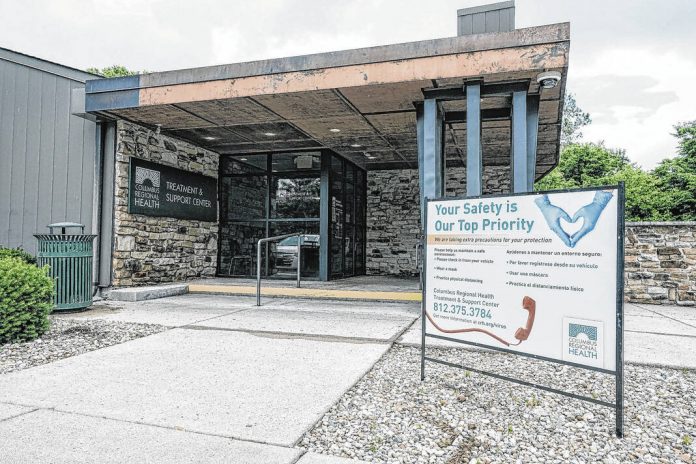
Mike Wolanin | The Republic An exterior view of the Columbus Regional Health Treatment and Support Center in Columbus, Ind., Wednesday, June 9, 2021.
Some local officials say they are surprised that Bartholomew County has seen a dramatic decrease in overdose deaths over the first five months of the year, with the county currently on pace for its lowest annual total in eight years.
As of this past Thursday, there had been four confirmed overdose deaths in Bartholomew County, putting the county on pace for roughly 11 deaths this year, according to figures from the Bartholomew County Coroner’s Office.
That would be a dramatic decline from last year — with a record 39 overdose deaths in the county — and the lowest yearly total since 2015, when there were six deaths. It also would reverse trends seen in recent years as fatal overdoses increased each year from 2019 to 2022 and set records in 2020, 2021 and 2022.
By comparison, the county had recorded 15 overdose deaths by April 19, 2022.
While local officials across the county are celebrating the dramatic drop in deaths so far this year, some cautioned that they don’t expect the decrease to continue — particularly with local treatment facilities seeing record demand and the illegal drug supply continuing to be as dangerous as ever.
“I’m very surprised by the drastic reduction in overdose deaths so far this year,” said Dr. Kevin Terrell, medical director of Columbus Regional Health’s Treatment and Support Center, or TASC. “I’m thrilled by this wonderful news, and I really hope this indicates a new trend for the future in Bartholomew County. Unfortunately, I’m not optimistic that the news will be so rosy for the rest of 2023.”
“The main reason it’s so hard for me to imagine that we’d have an abrupt and lasting end in overdose deaths is because of the history of rising overdose deaths every year over the past several years,” Terrell added. “I just can’t imagine that overdose deaths would just stop happening.”
And Terrell is not the only official who was surprised by the drop in deaths. Sherri Jewett, executive director of the Alliance for Substance Abuse Progress, or ASAP, also said that “the magnitude of the decline surprises me.”
What’s behind the decline
Officials said the decline offers some good news after a “disheartening year” and is a sign of hope that local efforts aimed at combating substance use are helping to ease a public health crisis that has killed 196 people in Bartholomew County since 2015.
Currently, local officials say there is no single explanation for the decline, but they believe a wide range of community efforts may be paying off, particularly as the COVID-19 pandemic fades and the community’s capacity for treatment increases.
“It’s not like we can point at one thing and say, ‘This is what did it,’ rather it’s the combination of all of things that the community has put together over the last few years” Jewett said, who added that the pandemic has been a “wild card” that has made it “very difficult to predict what’s going to happen.”
Jewett pointed to, among other things, expanded treatment options in the community, as well as the addition of more recovery housing, the Bartholomew County Jail Treatment Program and harm-reduction measures such as the distribution of naloxone and fentanyl test strips, as potential contributing factors to the decline.
Naloxone is a nasal spray often sold under the brand name Narcan that can temporarily reverse an opioid overdose. Fentanyl test strips seek to help drug users determine whether a drug contains fentanyl, a synthetic opioid that is increasingly being mixed with other drugs, often without the user’s knowledge.
Bartholomew County Coroner Clayton Nolting, who also is a Columbus police officer, credited part of the decline in deaths to the arrest and prosecution of drug dealers, as well as community-wide efforts and information-sharing initiatives.
“It’s good cooperation and good information sharing that I think has really led to a lot of this,” Nolting said.
Bartholomew County Sheriff Chris Lane said “the biggest thing I can think of” is the community opening back up as the pandemic waned, with more people able to get into treatment, see therapists and attend recovery meetings than during much of the pandemic, when capacity was limited due to public health concerns while the stress and isolation of the pandemic led to a rise in relapses.
“Of course, everyone blames COVID for everything,” Lane said. “…The end of last year, we were working our way out of that where everything was opening back up. I’ve got to believe that is contributing to this decrease. …Now everything has opened back up and they can go to their counseling sessions. That has got to help.”
A dangerous drug supply
At the same time, officials cautioned that the illegal drug supply continues to be flooded with deadly fentanyl, a synthetic opioid that is more potent than heroin that local officials say has largely fueled the historic rise in overdose deaths in Bartholomew County over the past few years.
The drug has quickly become “the primary fatal drug in drug overdoses,” local officials said in earlier interviews. Terrell said fentanyl “is the only opioid we have seen at TASC for the past two years.”
Last year, fentanyl was the most common drug involved in overdose deaths and was detected in 27 of the 39 deaths, according to the Bartholomew County Coroner’s Office most recent annual report. So far this year, the synthetic opioid was detected in three of the four overdose deaths in the county.
Additionally, new illegal drugs “are constantly being developed,” including the nitazene, a synthetic opioid that can be more potent than fentanyl, and xylazine, an animal sedative known as Tranq.
“Both of these drugs are now contaminating the illicit drug supply in various parts of the country and causing overdose deaths,” Terrell said. “These drugs – and others that are on the horizon – will probably continue to increase overdose deaths on our community as they spread to us. It feels impossible to keep up with the illegal drug manufacturers and the dealers.”
Mirroring trends?
Currently, it is hard to say if the local reduction in overdose deaths is mirroring trends seen in other parts of the state and country.
The most recent data from the Centers of Disease Control and Prevention suggests that there was a 2.8% decline in overdoses deaths in the U.S. in November 2022 compared to a year earlier. In Indiana, overdose deaths declined nearly 20% in 2022 compared to 2021, according to provisional figures from the Indiana Department of Health.
Last month, Kentucky Gov. Andy Beshear said overdose deaths in that state fell by 5% in 2022, The Associated Press reported. Massachusetts officials also reported a 1.5% decrease in overdose deaths during the first nine months of 2022.
But the decrease in Bartholomew County is several orders of magnitude greater — amounting to about a 72% decrease compared to 2022, if the county maintains the current pace.
While officials hope that local trend continues, they said the community should be prepared for the possibility that overdoses rise again.
“My response is to celebrate this great news but to expect overdose numbers to rise,” Terrell said. “With that expectation, TASC will continue doing our part to bring more people into treatment and to try to keep them engaged in treatment. I don’t enjoy raining on the parade, but I believe we should be prepared for the possibility that this is just a lucky first few months of 2023.”




